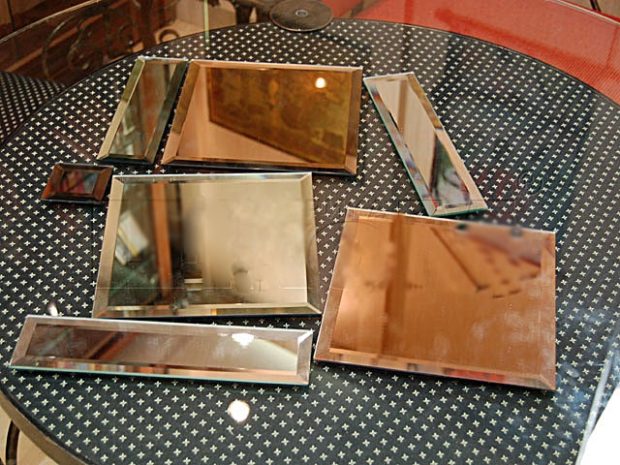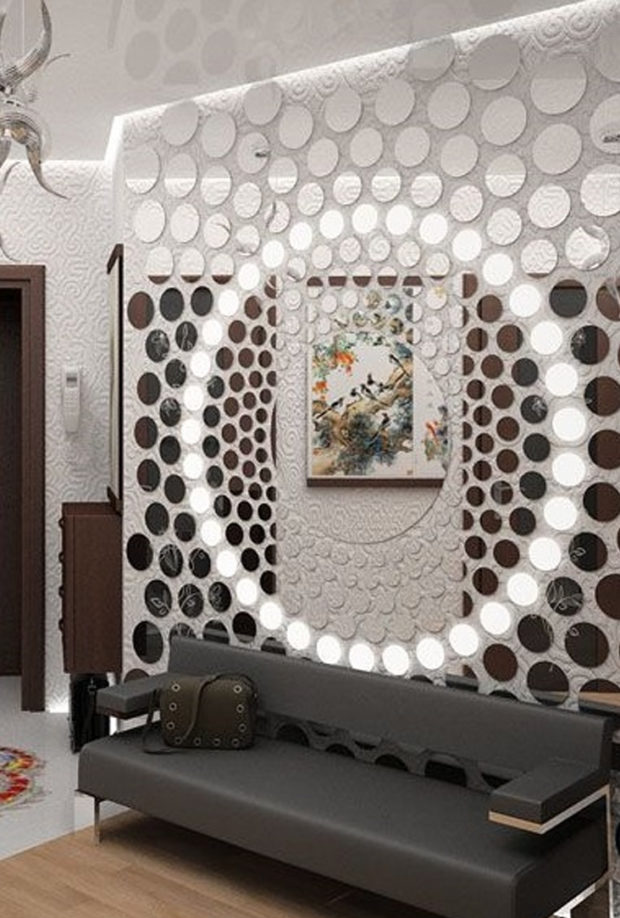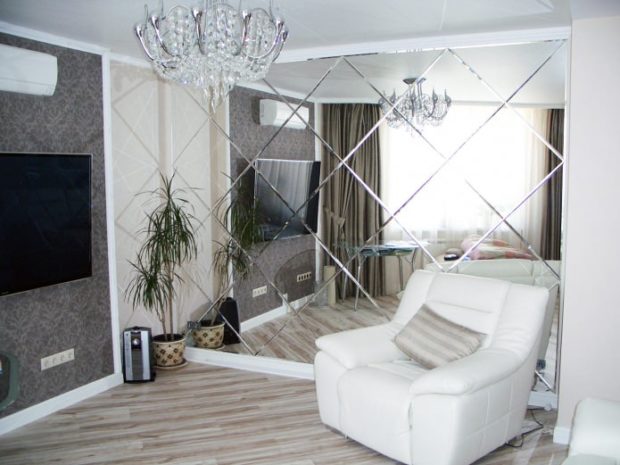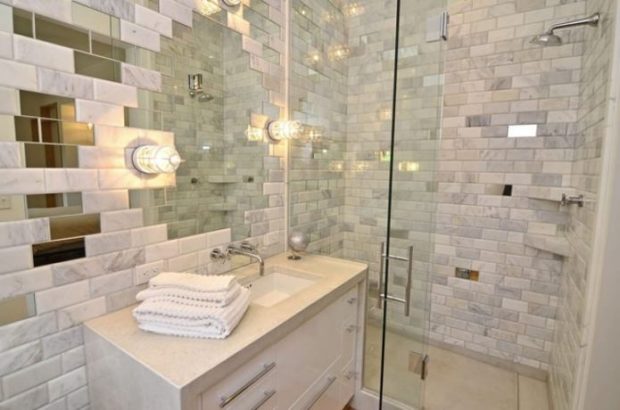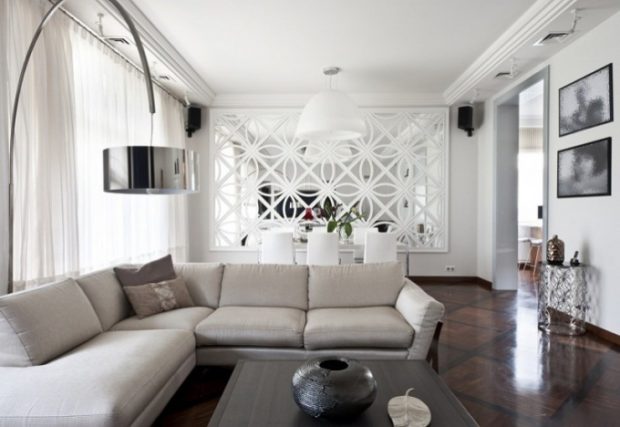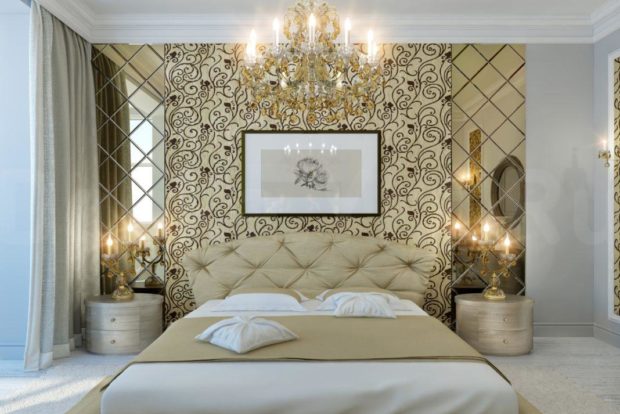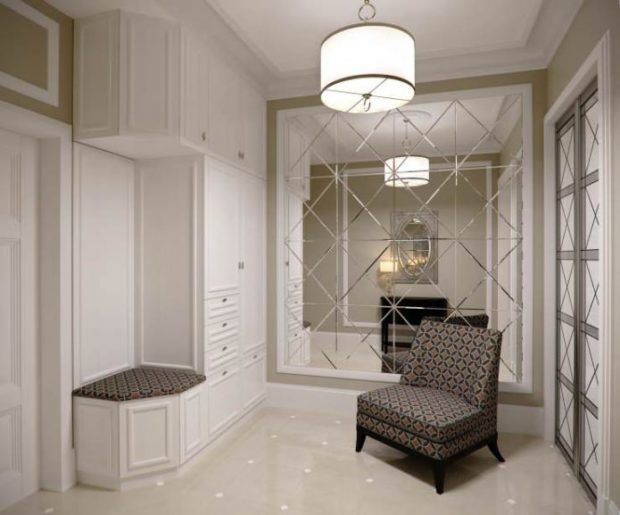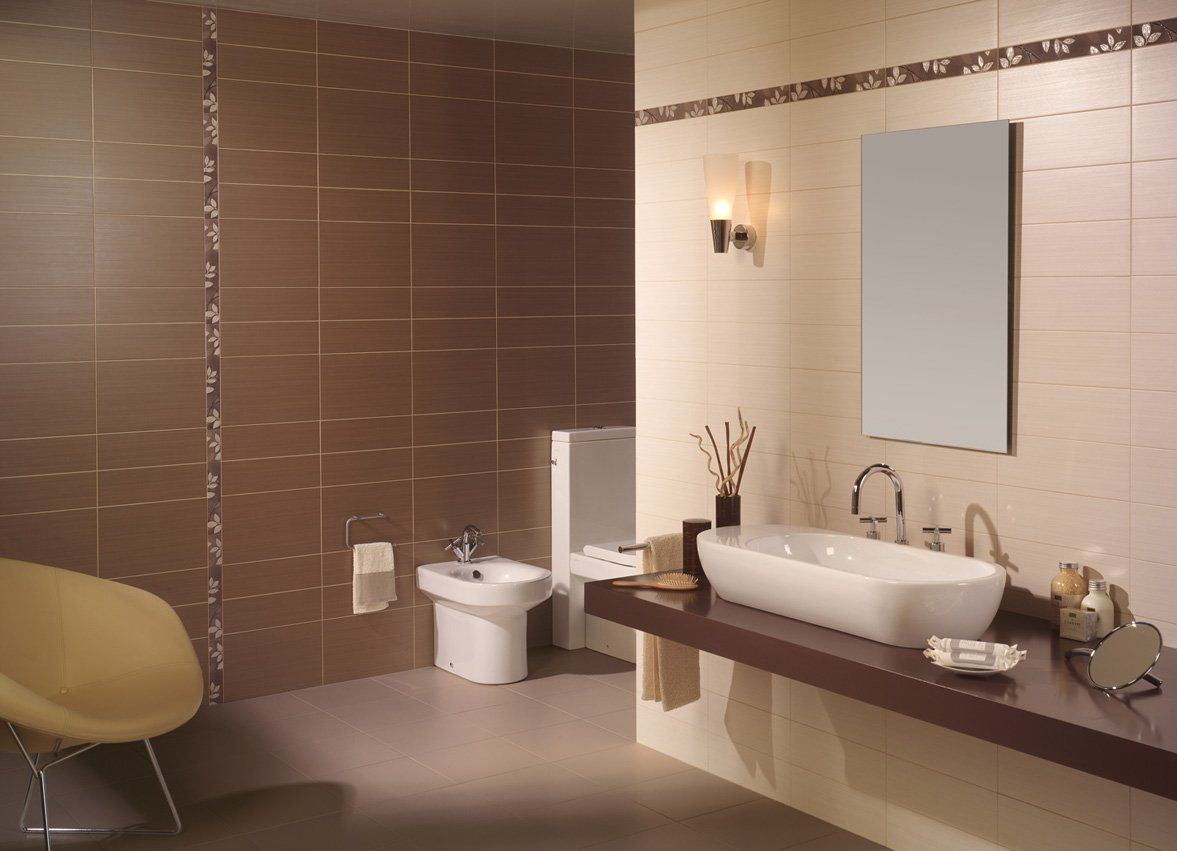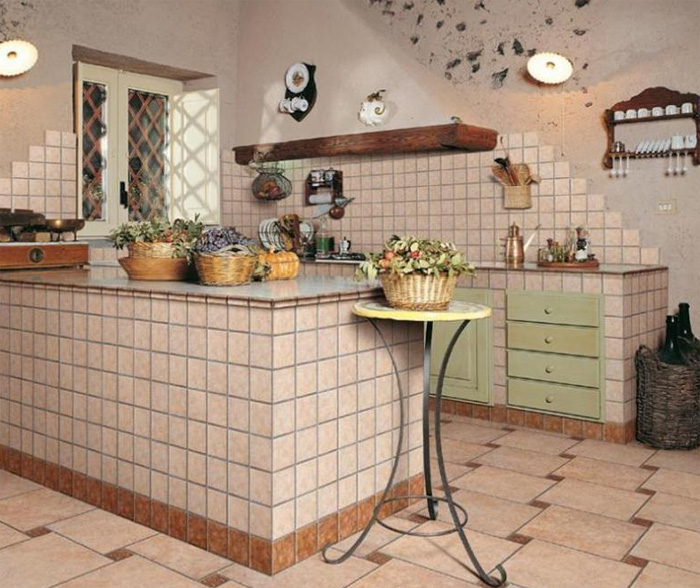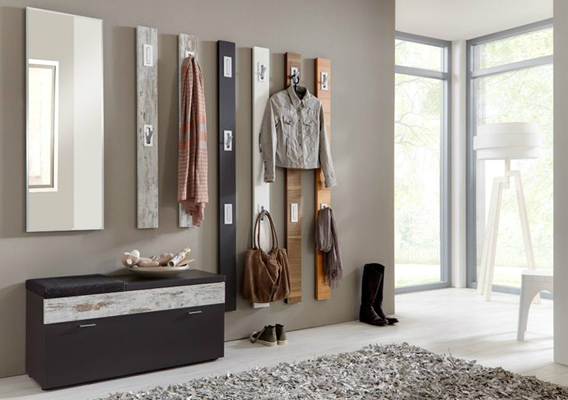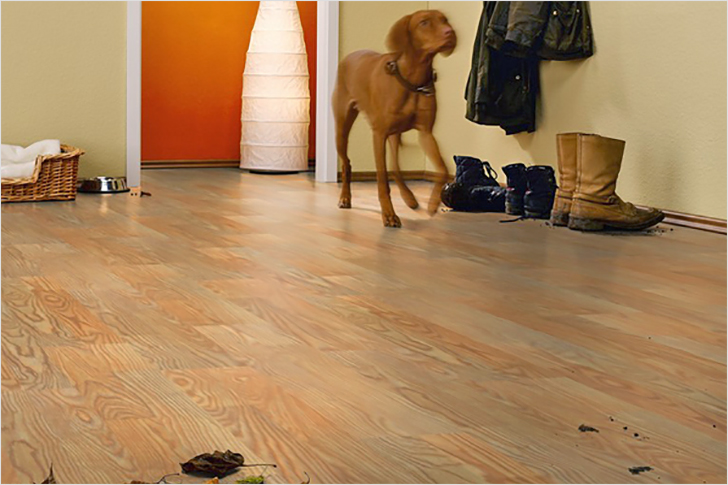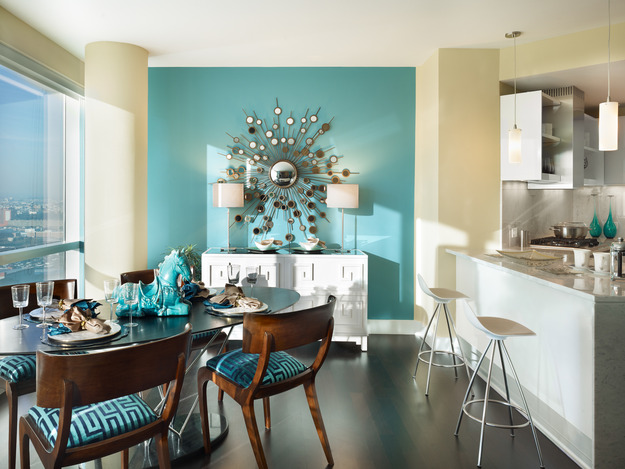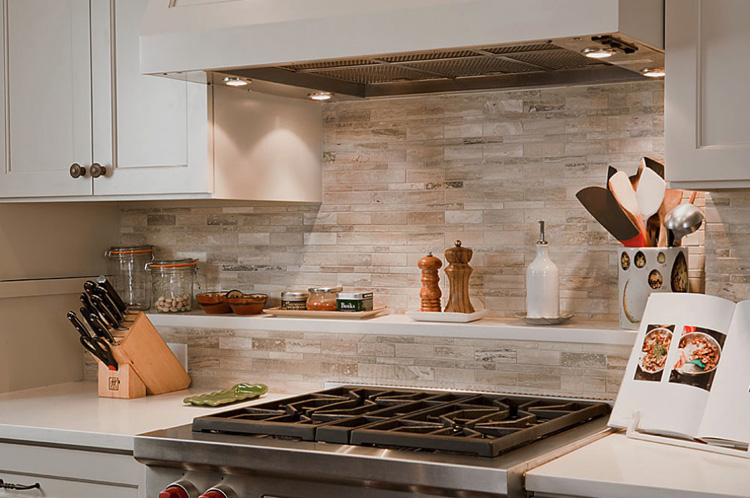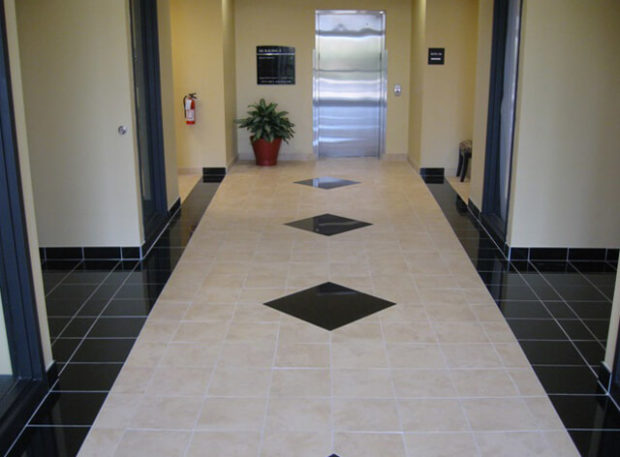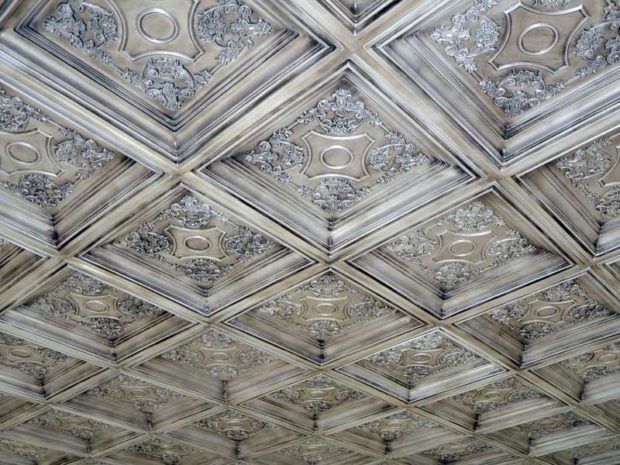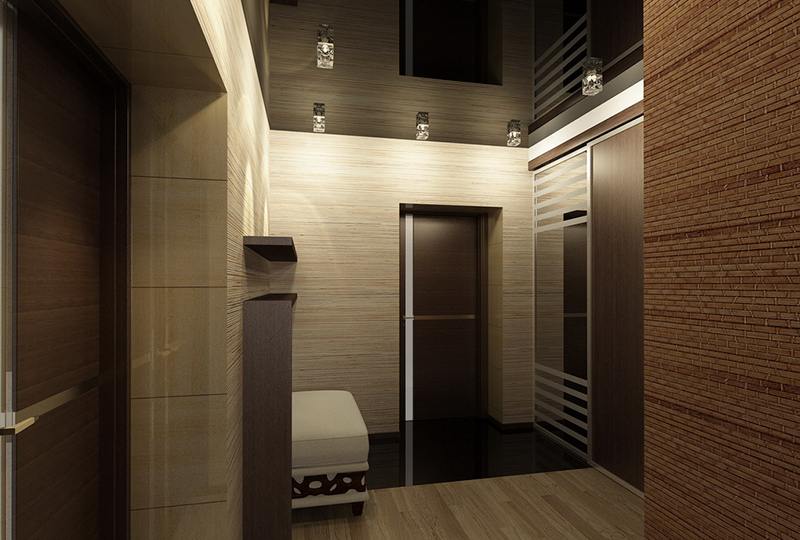Mirror tiles in the interior: 5 tips for use + photo
When it comes to the upcoming repair, the question immediately arises - how to do future interior unusual and modern. Keeping up with the latest fashion trends in the field of interior design is sometimes very difficult. After all, as soon as you find on the Internet, an image with the room decoration you like, how literally in a couple of weeks eminent designers will find even more interesting finishes. A win-win way still remains mirror tile in the interior. We will give some tips on its use in various rooms and consider its main types.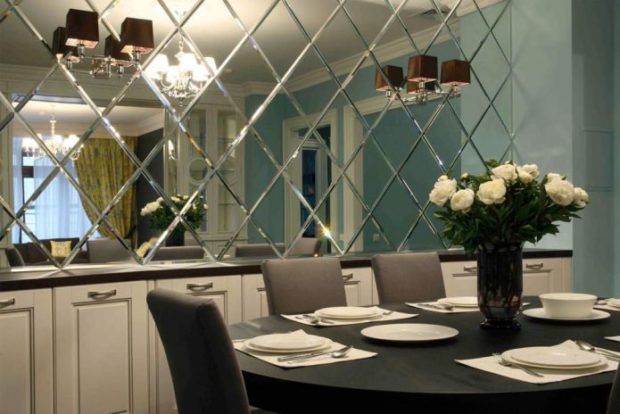
1. Classification of mirror tiles
The range of shapes and textures of this facing material is actually much more diverse than it might seem at first glance. The very first criterion by which a tile is distinguished is manufacturing material. There are three options in total:
- Mirror glass tile;
- From polished metal;
- From solid high-quality plastic - polystyrene.
The second and third type of material only serves as the basis for applying a mirror coating. The reflective surfaces of such a tile will be worse than a real mirror. In addition, metallic paint may slightly distort reflection. But the cost will be lower. The basis in these cases can be self-adhesive, which greatly simplifies the installation process and the costs associated with it. Tile from This mirror glass is classified by the following parameters:
- By processing method edges - may have dull, polished, or edges with a facet - cut edges. The latter option immediately makes the cost higher, but it looks very impressive. Sunlight or light flux from various fixturesreflecting from their surface, it creates a lot of sunbeams or bizarre glare. At the same time, the interior becomes more mysterious and voluminous.
- In shape - can howl made in the form of squares, rectangles, mosaic elements, narrow stripes, triangles. The latter are almost always issued with a facet. Narrow stripes are often used in the form of friezes or decorative borders. Non-standard forms include - a rhombus, a hexagon, a semicircle, a quarter of a circle.
- By color - not have shades, that is, a neutral mirror surface, or have tinted. The most common colors are bronze, gold, graphite, blue, green. In addition, there are many other colorful options. Color selection should be based on room decoration style. For loft style, modern or minimal often use more restrained shades. Gold and bronze will add luxury to the classic style.
- By sight surfaces - plain, with an ornament, with standard abstract patterns or patterns that are applied using sandblasting or thermal printing, with an image made according to your individual desire.
- By appointment - distinguish universal, wall and floor tiles.

It is sometimes simply impossible to distinguish what material a particular type of tile is made of, simply by its appearance. If your goal is to purchase exactly the mirror version, then you can determine it by weight. It will be much heavier than a plastic or metal base.
Standard sizes This finishing material allows you to easily choose the most suitable option - 10 × 10, 15 × 15, 18 × 18, 20 × 20, 25 × 25, 30 × 30, 40 × 40, 50 × 50, 20 × 30, 30 × 45 , 30 × 60 cm. At the same time, some manufacturers may offer you tiles from 6 × 6 cm in size on request. The standard thickness is 4 mm. Such a wide selection makes it possible to combine it with the usual ceramic tilesavoiding a large difference in the lengths of the faces. An interesting option are ready-made kits which, after laying, form whole panels. They can transmit a wide variety of images or create a pattern using elements of different sizes.
Concerning mosaic option execution, the standard sizes of one fragment can be - 20 × 20, 42 × 20, 50 × 50, 149 × 10 mm. This type of tile is sold in sheets. In the form of a base is a flexible mesh material on which squares of the above sizes are glued. Between them there is a gap for seams, the standard width of which is 2 mm. Due to this structure, using mosaics, it is easy to veneer radius surfaces. Pillars look especially exquisite columnsdesigned this way.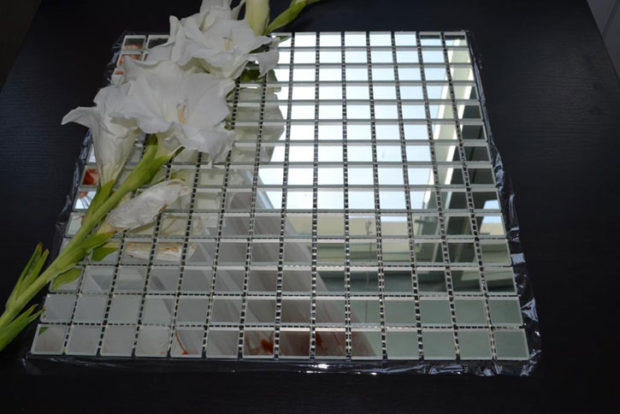
2. Advantages and disadvantages
Like all finishing materials, mirror tiles have a number of pros and cons that you should be aware of. Start with good:
- The material is moisture resistant, which makes it ideal for use in rooms with high humidity;
- Fire safety- the material does not support the combustion process;
- The surface is resistant to alkalis and acids;
- Ease of care;
- Long life time subject to installation technology and normal conditions in the room;
- Stunning decorative properties, which include not only the originality of the idea itself, but also the attractive and unusual appearance of the surface lined with this material;
- And the most important thing - the possibility of modeling space. In other words, with proper use, you can visually increase a small-sized room - "push" the walls and even raise ceiling level.

Now about disadvantages:
- The material is very brittle and its edges are prone to chipping. With inaccurate installation and transportation, this cannot be avoided;
- If the mirror fragments are not arranged correctly on different surfaces, you may experience maze effect which has an oppressive and overwhelming effect on the human psyche;
- The surface is easily prone to scratching and does not tolerate contact with abrasive substances;
- If the room is bad aired, over time, the surface of the tiles may darken.
As you can see, cons are easily removable and can only occur from ignorance of features work with this material. Choose trusted sellers who value their reputation and respect their own products. This can guarantee the availability of individual packaging and cargo insurance during transportation. So you, in turn, will be safe and insured against the purchase of damaged goods. Installation of tiles can be entrusted to professionals with experience who provide a guarantee for their work. And to avoid mistakes on the use of mirror tiles in the interior, our article will help.
3. Recommendations on the use of mirror tiles on various surfaces
Designers just love to work with this type of material. All thanks to the fact that with its help you can instantly change the interior in the most incredible way.Even small fragments can bring a new mood into the atmosphere of the room. The most common surface for translating ideas, of course, is the wall. But many recommend using reflective elements on the ceiling and even on the floor.
Secrets wall decoration
It is unlikely that the owners small apartments deny yourself two pleasures at the same time - it is beneficial to emphasize individuality premises and make it more spacious. All this will be possible if you stick to simple tips:
- Main rule the use of tiles on the walls - do not trim it with two opposing walls. This will create the illusion of an endless corridor. It is in this case that a negative effect on psychological health will manifest itself. Such a visual illusion distorts space makes our brain work actively in search of a way out of the formed labyrinth. You can forget about the rest in such a room.
- Finishing can only be affected part of the wall or a small fragment thereof. Think about which of the walls you want to highlight, what you want to demonstrate to your guests. After all, such an element will immediately attract attention. Even a small panel above a sofa already a self-contained decoration. For a background it is better to use neutral shades of paint or of wallpaper. And to further emphasize this highlight of the interior, you can dress it in beautiful frame.
- To visually raise the ceiling lining is performed in the form of vertical strips of small width. Elements can be both paired and single. Repeating elements should be thinner, while a single strip should occupy about 1/3 of the wall surface. In this case, the most optimal location such an element - on the longest wall.
- A solid mirror wall enlarges the room, and several narrow stripes make spacious rooms more comfortable.

- To fill with light dark room, place the mirror panel on the wall opposite the window opening.
- Niches, the back wall of which is laid with a mirror mosaic, will seem deeper. And with proper lighting, this effect will be transmitted to the whole room.
- It looks very original combination ordinary tile with a mirror. For best results, very important pick the same size of two elements. Subject to this condition, the composition will be holistic and harmonious.
- For facing two adjacent surfaces For example, the angle between two walls or the junction of a wall and ceiling, use different tile options. One can be plain, the other with a picture, color and plain.
AND remember that the effect of increasing space is achieved precisely due to the presence of reflection in the mirror elements. Therefore, it is very important subject of reflection. The interior should be carefully thought out. You see, if a massive wardrobe is reflected in your mirror wall an infinite number of times, then you will get the feeling that you are in a cave. And a completely different impression will be created by the reflection of the window opening and sunlight. Carefully choose location - this is the key to a successful result. Also, carefully consider the placement of lighting fixtures. Glare and sunbeams can interfere and weary vision. therefore fixtures better placed at the edges, and not opposite the mirrors. Then the light from them will be reflected from the surface more gently, tangentially and not create discomfort.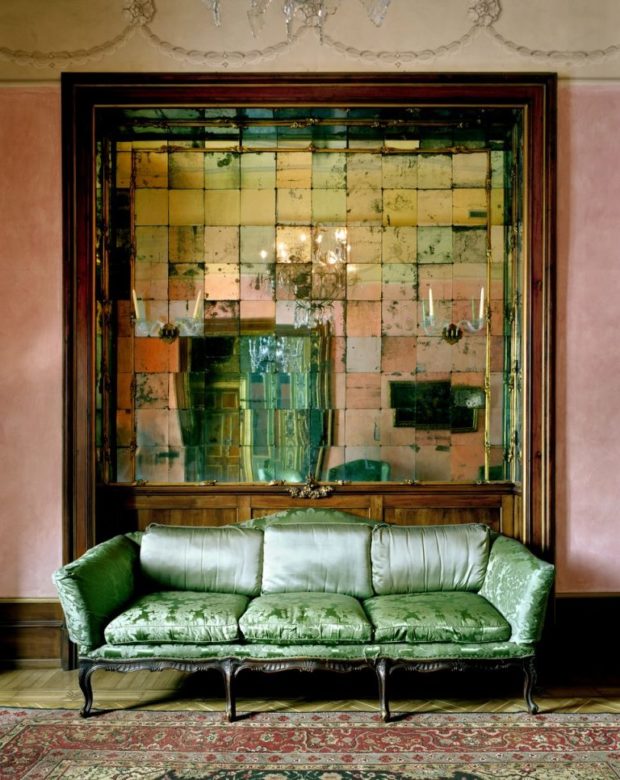
Mirror ceiling - yes or no?
This unusual trick is very rarely seen in the interior of the apartments. This is due to the fact that he has not yet gained the due popularity and requires a competent approach. When is it advisable to use mirror tiles on the ceiling?
- Designers claim that this is a good solution for small rooms with very low ceilings.This does not mean that the entire surface should lend itself to such a design. Select a small area. It can be corners or the center of the ceiling. Separate it with a beautiful decorative baguette, giving the desired shape. Fill the inside with mirror fragments. It is especially successful to use this technique to finish the area around chandeliers. Reflecting plafonds going up will instantly erase the borders.
- Do not abuse. Otherwise, you risk creating an inverted space effect. Remember the Looking Glass from Alice in Wonderland? It will be very difficult to be in such a room.
- Spacious rooms whose ceiling is fully tiled will appear cold and empty. Therefore, you are mistaken in thinking that the area in this case matters.
- View used tiles should depend on the type of ceiling. Concrete and overboard ceilings can withstand real glass. To decorate stretch ceilings use a mirror PVC film. And Armstrong-type suspended ceilings involve the use of lightweight materials based on plastic.

Mirror floor in the interior of the apartment
This is probably the most custom solution for finishing floors. Nevertheless, there really is a special floor variety of mirror tiles. They make it from a mirror web of increased strength and wear resistance, which at the same time has a very large thickness. Its surface is not subject to mechanical stress. All of these factors together are doing this type of facing material incredibly expensive.
As for use in residential premises, you should think twice before deciding to take such a step. Lay carpet covering on such a floor is simply impractical, given its cost. This means that you will always see a reflection of the ceiling on the floor .... The sensations will be rather strange, it is possible the appearance of dizziness and disorientation. Therefore, no matter how interesting and attractive this crazy idea may seem to you, it is better to abandon it in time. Not only that, you will spend a large amount on the purchase of material, so over time you will spend at least not dismantling, buying and laying another coating.
The only thing that you can safely do is use small mirrored elements to diversify the usual tile. They have the shape of a square, measuring 50 × 50 mm or more and are inserted between tiles that are laid with offset. This method is quite acceptable for apartments or houses. Completely mirrored floors very rare, but can be found in huge shopping centers. This serves as an excellent way to attract customers. If you want, you don’t want to, but you’ll come in to look at the upside-down windows, and you’ll buy something.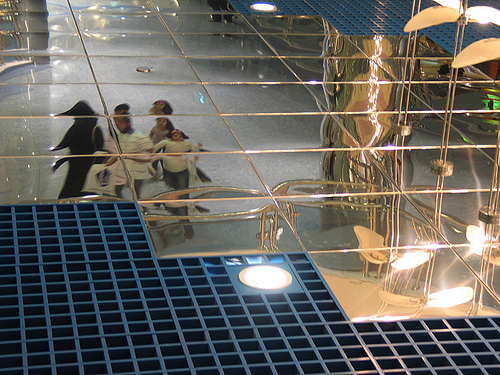
4. In which rooms is it appropriate to use mirror tiles
If you have decided for yourself that such an element in your apartment should be, it's time decide in which same the room it is worth placing a similar decor, and in which not. Let's start with the main thing - no place mirror tiles in children's interior rooms. Immediately answer the question “why?”:
- This material is quite easy to break, crumble into small sharp pieces and get hurt. Even if you use not real glass, but plastic, its fragments can also be very dangerous.
- The baby will definitely not be able to evaluate the fashionable and modern trend for the first 15 years. So, you are doing this exclusively for yourself. In this case, place a mirror panel in your room.
- Children's unstable psyche can ambiguously perceive such a technique. Reaction child may be unpredictable.
- From the point of view of comfort, this is not the “warmest” material for decorating a child’s room.
In all other rooms you can not limit your own imagination. Let's consider in more detail.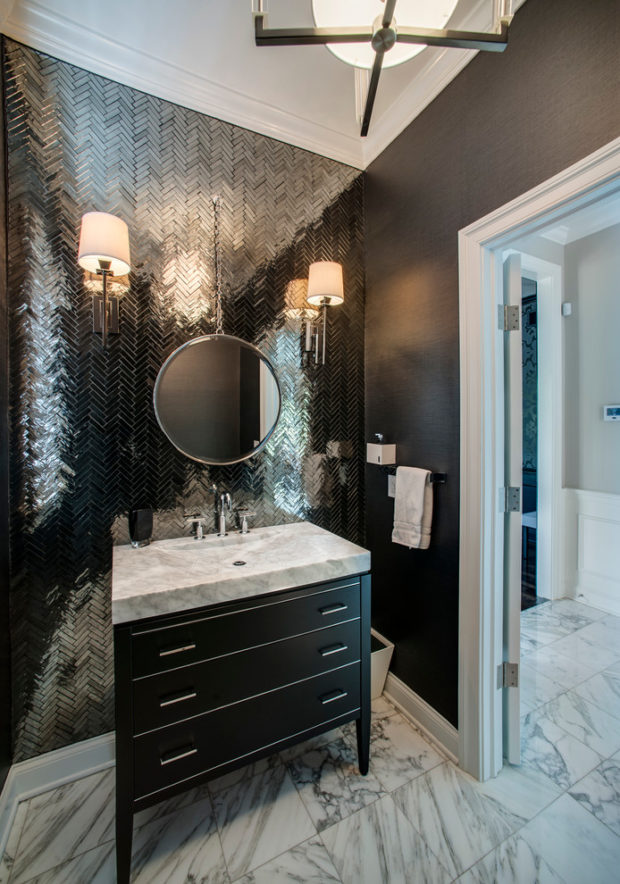
Mirrored interior of the dining room or bathroom
Due to its positive qualities, this type of tile is an excellent solution for use in rooms where is present constant humidity and temperature changes.
For the bathroom whose small sizes often do not allow the full use of various techniques to increase space, it's just find. You can not only diversify the interior, but also make it more spacious. In addition, if you select a suitable tile in shape, you can replace her usual washbasin mirror, which simply can not do. The remaining walls can be decorated with ornamental tiles or plain mixed with tiles. Only in this room does the concept of “too” completely disappear. The most interesting cladding options mirror tiles in the bathroom:
- Tiles of large or medium sizes of square shape, laid diagonally around the perimeter of the entire room;
- Rectangular tile in the form of bricks, laid in combination with ceramic;
- Mirror mosaic in combination with plain or color mosaic from another material;
- Blotches of mirror fragments randomly mixed with tiles of the same size;
- The cladding of all walls is completely plain or in combination with the same color mirror tiles.

The only disadvantage The use of mirrors in the bathroom is to fog up when using hot water. You will need to constantly wipe all the walls dry so that there are no soap and lime marks from hard water.
IN the dining room Mirror tiles look equally well both in the working area and in the dining room.
- For decoration working apron very often recently used mirror tiles made of stainless steel. It looks very impressive and resembles fish scales. To facilitate care for such material you need to take care of the availability of powerful hoods, which will prevent the formation of soot and greasy plaque.
- Glass tile in the form of bricks goes well with tiles of the same shape that imitate the surface of natural stone.
- IN dining area fragments of mirror tiles use for wall decoration. Opposite longitudinal diagonal stripes look good kitchen table. This technique looks modern and unusual. You can emphasize it and give home comfort with the help of small fixtures.

Spacious entrance or dressing room
IN hallway as in the bathroom, you can not do without full-length mirrors.
- Use a large tile with smooth edges, which should be laid with minimal seams in the entrance area. In a place where there should have been an ordinary mirror. This will help to see a single, not fragmented, reflection. The complete absence of seams is impossible.
- If corridor a long, it is recommended to venerate a fragment with a wall length to the right or left of the front door.
- According to the rules of Feng Shui, you can not place a mirror surface on the wall in which is reflected Entrance door.
- If the room is dark complement mirror masonry lighting fixtures. This will immediately increase the amount of light and make the room more spacious.
- An interesting solution would be the decoration small mirrored elements unusual shape. For example, hexagons or semicircles. Tinted fragments against the background of light walls look advantageous.

For dressing room especially if she is assigned modest in size, finishing one of the walls with mirror tiles completely, will have double benefit. There will be much more space, and the need for an ordinary mirror will disappear immediately. In this case, you can combine two types of tiles. For example, in the middle of the wall from floor to ceiling, lay out the usual mirror, and on the sides - a tile with patterns.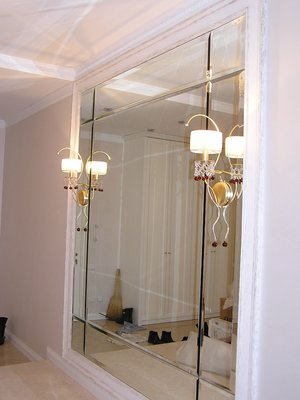
Mirror tiles in the design of the living room or bedroom
Use case ceiling mirrored elements It looks most appropriate in living room.
- Multilevel stretch ceilings can be varied with the help of a mirror film.
- The wall, fully finished with mirrors, also harmoniously fits into this room. Opposite it, it is better to have indoor plants, the number of which will visually increase, due to the properties of the mirrors.
- Mantelpiece zone advantageously emphasized mirror elements in combination with other finishing materials, for example, plastic panelsimitating wood or stone.
- In the living room, you can also combine different types of tiles.
- Mirror panels are best placed above the sofa.

Bedroom implies a good rest and healthy sleep, therefore it is strictly forbidden to use mirrors in large quantities. It is understood that only one wall should be allocated for them. But it will be completely covered with tiles or not - a matter of taste.
- Optimal place the location of the mirror tiles in the bedroom is above headboard.
- On the sides of the bed in the form of mirror columns of rectangular or semicircular shape.

This is because, for many people, a copious amount of reflective surfaces can cause embarrassment.
5. Recommendations for self-installation
Many are used to doing all the repair work in the house with their own hands. Someone, thus, saves money, someone simply does not trust unfamiliar masters. Whatever the reasons, if you decide to lay the mirror tiles yourself, you need Know the key points. The surface must be prepared as before laying regular tiles. But the process itself mounting has some features:
- Before laying, lay all the tiles on the floor in the required sequence. Estimate the width of the gaps and the need for trimming;
- Pre-size all elements;
- If the surface of the tile is opaque, but at the same time smooth, then it is necessary to create a slight roughness on it. To do this, sprinkle it with coarse-grained sand. This is done to provide better adhesion to the base material;
- If the tile is transparent, apply on the back liquid glue and coarse sand is added;
- As adhesive mixture use liquid Nails or neutral silicone without acid in the composition;
- The edges of the mirror tiles will have certain deviations from uniformity, so make seams with a thickness of at least 2 mm;
- First row must be horizontal;
- Press the tiles with a piece of cloth. This will help to avoid pollution;
- Finish film should be removed only after completion of all work;
- Ready masonry should be left for several days until completely dry;
- Only after that proceed to grouting seams with special silicone;
- After it dries, clean the surface of the tiles with a dry cloth. Material is best suited for this. microfiber.

After the successful completion of installation work, you can enjoy the unique design made by yourself.

